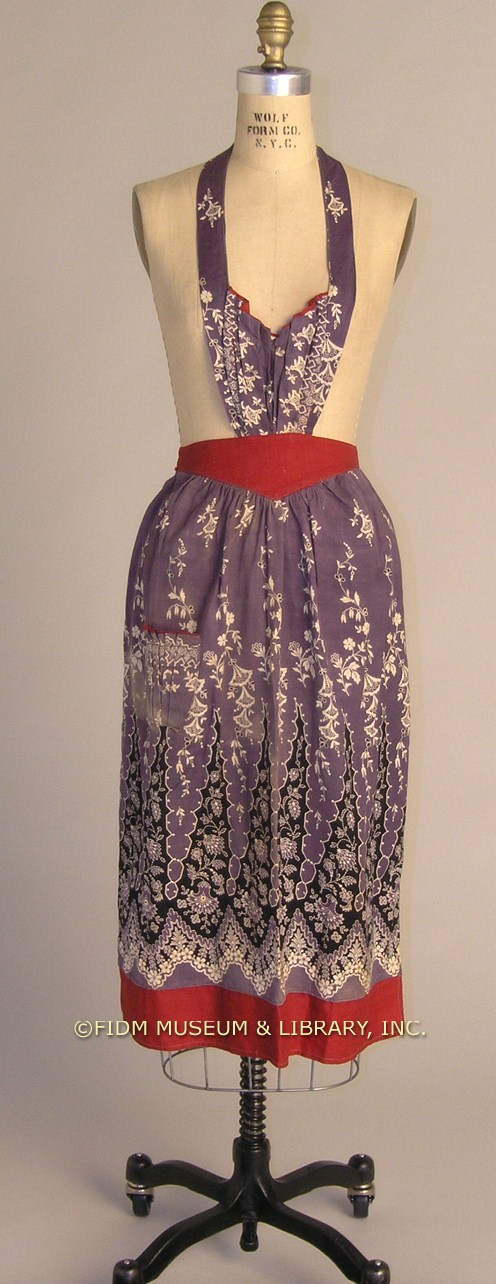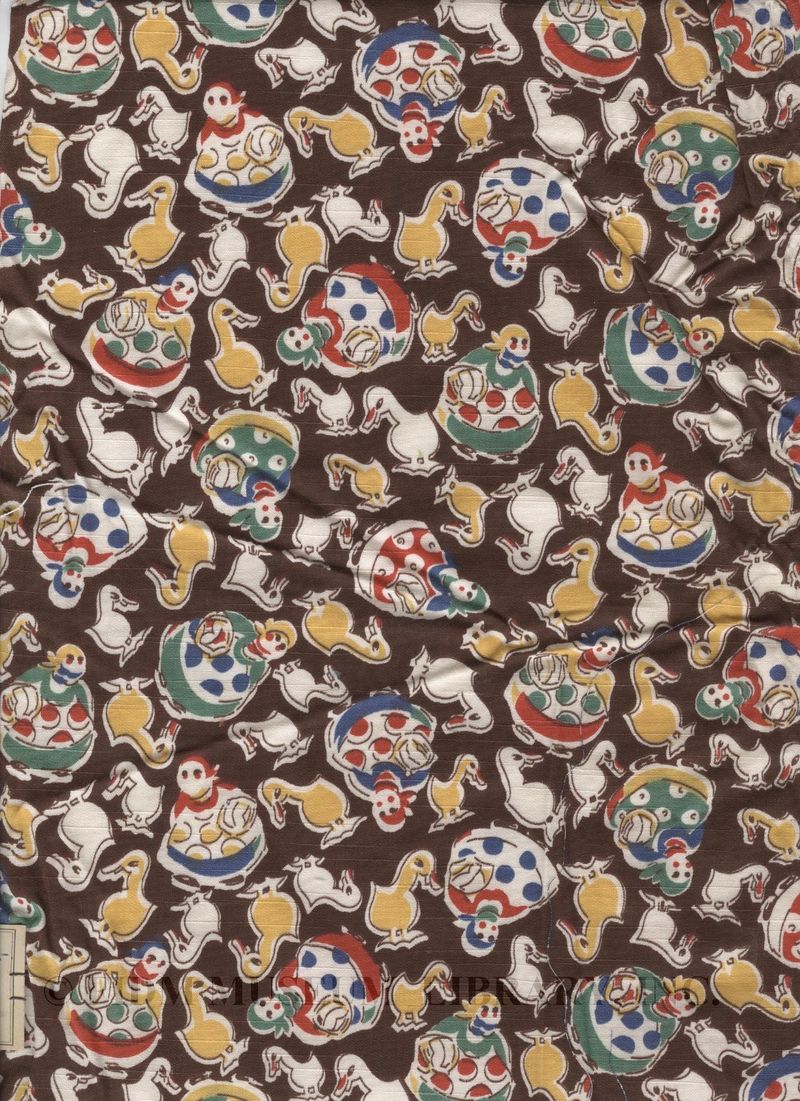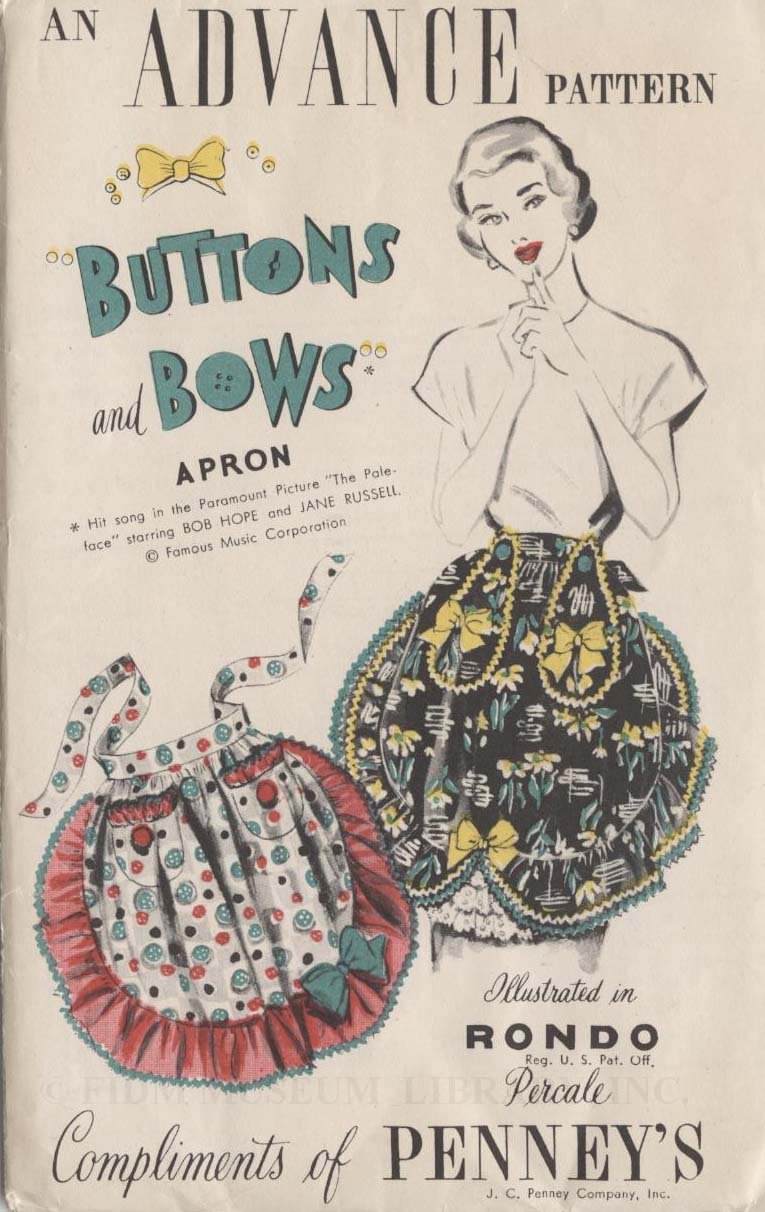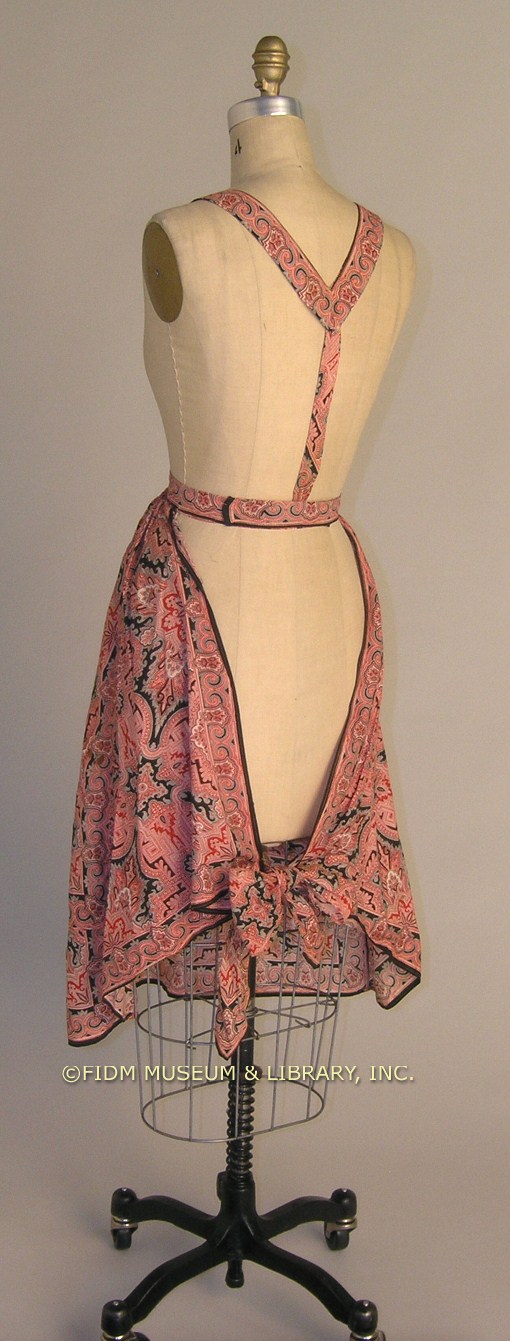In practical terms, aprons are merely protective overgarments, worn to prevent food or dirt from staining the clothing underneath. Despite these functional origins, aprons have taken on the much larger role of signifying feminine domesticity. This is particularly true of aprons featuring brightly patterned fabric or decorative embellishments. In the late 19th and through the mid-20th century, plain, utilitarian aprons were worn while doing actual work in the kitchen or home, while colorful aprons were worn when receiving guests or serving food. Thus, decorative aprons came to be associated with competent and dedicated homemakers. Even today, an image of a woman or man wearing an apron is intended to convey domestic prowess.
The distinction between plain and colored aprons was particularly important in the late 19th century, when many households began to hire servants. In order to provide visual differentiation between hired servants and the lady of the house, household maids were always clothed in white aprons when interacting with visitors. In early 20th century pattern books and kitchen manuals, white full aprons are usually labeled “maid’s aprons” while those made of patterned fabric are designated “fancy aprons.” Though fancy aprons were not strictly necessary, it was suggested that no woman’s wardrobe was complete without a few fancy aprons to spruce up her everyday dress.

Fancy apron
1895-1905
Gift of Ms. Judy Thomsen
2004.823.3
Though ready made aprons were available, fancy aprons were often made out of fabric leftover from other projects. This frugality served the dual purposes of saving money and of demonstrating sewing ability. This fancy apron was possibly made from a scarf or other large panel of fabric as there is a distinct border visible at the hem. This same border print also appears in the shoulder straps and waistband. Though the apron is made of a printed cotton, the dense allover print resembles those found on woven wool paisley shawls, a popular accessory through the 1860s. Printed imitations of the paisley shawls were widely available. When the paisley shawl went out of fashion, a frugal woman perhaps used her inexpensive printed version to create the fancy apron seen here.
The full skirt of this fancy apron can be tied in back. This would provide full coverage of a woman’s skirt and suggest that this apron might have been worn for very light housework. Alternatively, it might have been worn while sewing, another occasion when it was appropriate to wear a fancy apron.

Fancy apron
1895-1905
Gift of Ms. Judy Thomsen
S2004.823.2
This purple and black apron also appears to have been re-purposed from a printed cotton shawl or fabric panel. The delicate white floral patterning is intended to resembles lace patterns.

Printed cotton swatch
Fall 1938
Gift of Roberta Tuller
2006.865.18
This whimsical printed cotton fabric is characteristic of 1930s textiles, which often featured small, allover prints. The apron wearing farm wife demonstrates the original function of aprons while still maintaining the link between woman and apron. It also hints at aspects of European traditional or folk dress, of which highly embellished aprons were often an important component.

Buttons and Bows apron pattern
1948
Gift of Stephen Porterfield
2007.897.28
This pattern for a fancy half-apron was a give-away promotion for the 1948 Bob Hope/Jane Russell film The Paleface. As the film is a Western which takes place in the 19th century, it would seem odd that that marketing strategy would include a contemporary, rather than historic, pattern give-away. Aprons, however, were at the height of their popularity in the late 1940s. Rosie the Riveter had left her factory job and was expected to focus her productive efforts on the home. Like all professionals, housewives needed a uniform and the decorative fancy apron became the visual signifier of the homemaker. Aprons of the late 1940s and 1950s were often tremendously creative, featuring ingenious use of pattern, texture and trim. Commercial patterns such as the Buttons and Bows apron pattern served as a starting point for these creative efforts.



Its nice to see some attention focused on more humble garments!
Don’t get me wrong! I love sighing over haute couture and high-end rtw just as much as the next person, but items such as home made aprons fascinate me just as much.
The way those (unknown) women used and exploited the print design of the scarves, with their prominent borders and graduated designs, was really ingenious.
Aprons seem to be enjoying a bit of a revival right now. There’s a thriving collectors’ scene for vintage originals, plus quite a few people/companies are producing modern replicas or reinterpretations. A cursory search on Etsy brought up hundreds of results!
Hi Sarah,
I’ve noticed the interest in aprons too. There are also many apron sewing patterns and pattern books available these days. I haven’t noticed people wearing/using these aprons, so I’ve wondered if it’s simply a new area of collecting. Or are they used for decorations?
Yeah, that’s funny – I don’t know anyone that wears them either! I must move in the wrong circles!
But then, they are an indoor garment so you’re not likely to see them worn unless you’re a house guest of an apron enthusiast. I’m guessing there’s a strong crossover with the 40s/50s vintage style fans who wear those styles on a regular basis. And make lots of cupcakes!
Hello Sarah,
A lovely piece on the oft forgotton apron. Your observance about servants aprons as opposed to the “Ladys” aprons I found interesting. As a domestic worker,(maid), I wear an apron as part of my uniform. However, my day/housework apron is not white but pink/white gingahm check),my evening apron being white with ruffled hem and bib.
There seems to be a revival in the wearing of aprons. Googling “vintage aprons” brings up many sites. There are even groups devoted to discussing sewing and wearing aprons. I might be in the forefront of the next fashion craze.
Thanks for the information.
Kim.
Kim,
Thanks for adding your perspective! It’s really interesting to hear about your evening apron, as it sounds very much like a 19th century maid’s apron. So interesting to hear that there has been so little change. Other professions have undergone uniform updates to reflect changes in taste, cultural shifts or innovations in materials…I wonder why this hasn’t been the case with aprons?
Hi Rachel,
You are correct in comparing my evening apron with a maids apron of 100years ago. My whole uniform is largly based on a victorian maids uniform, as it conformes with the surroundings and atmosphere where I work. However my “best” apron is so nice I need to don a work apron over it if I have to do kitchen work. I tried to find a likeness for you, the most alike is…
http://www.avcommunitytheatre.com/Photo%20Pages/My%20Fair%20Lady/Maids%201.jpg
I do think the long vintage style pinafore apron is not widely worn now. The same could be said for the starched cap and apron worn by nurses not that long ago. I also wear a “Edwardian” style apron for sunday school as a helper..
So interesting! Thanks for taking the time to send the image link. It’s interesting to think about the layers of aprons you wear for different types of work. Sounds like you actually have multiple uniforms! If you don’t mind me asking, what country do you live in? I live on the West Coast of the US and it’s hard to imagine this type of uniform anywhere here, as we are so focused on casual wear in all situations.
Rachel,
Send me an email I will get back to you.
Kim.
Thank you, again another great resource for my research. FIDM is an asset to us all.
Linette, It’s great to know that researchers find our blog useful!
I notice in old movies maids wearing strapless bib aprons, with no visible means of attachment to the uniform or dress.
Would you know how the bibs were held up?
Hi Penny,
Our Curator Kevin Jones informed me that this type of apron was known as a “pinner” – the top was held up by (you guessed it) pins!
Let us know if you have any other questions!